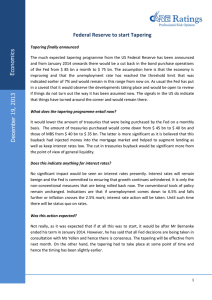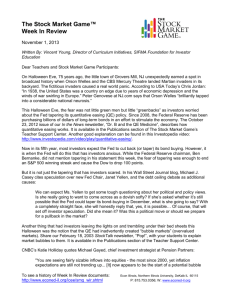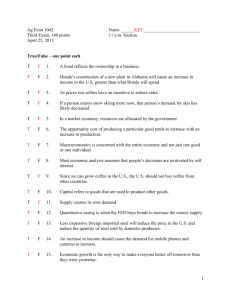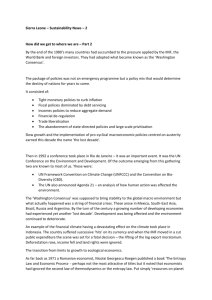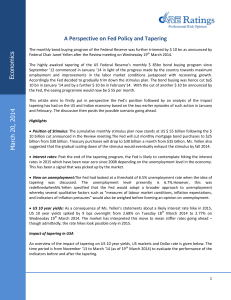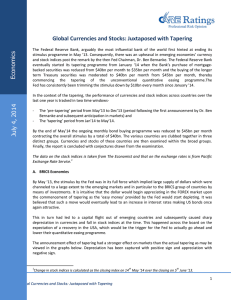Impact of QE3 Tapering on the Global Economy – Pertinent Articles
advertisement
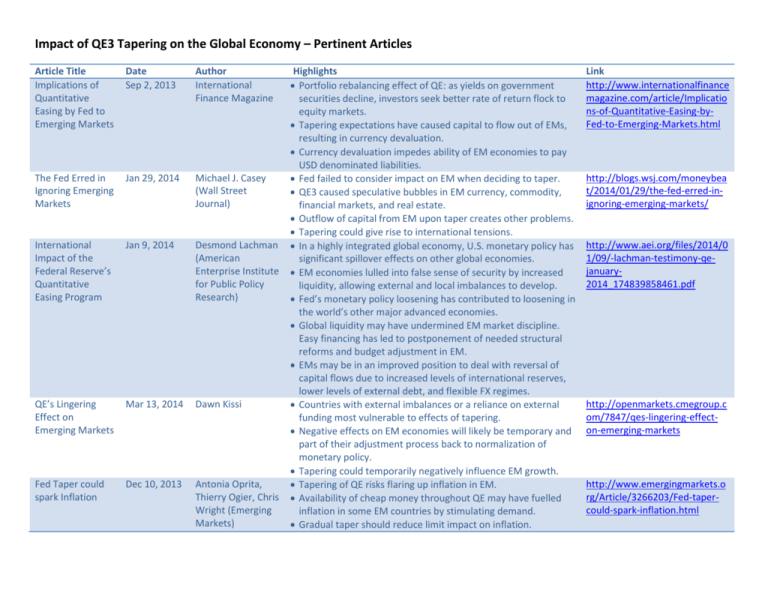
Impact of QE3 Tapering on the Global Economy – Pertinent Articles Article Title Implications of Quantitative Easing by Fed to Emerging Markets Date Sep 2, 2013 Author International Finance Magazine The Fed Erred in Ignoring Emerging Markets Jan 29, 2014 Michael J. Casey (Wall Street Journal) International Impact of the Federal Reserve’s Quantitative Easing Program Jan 9, 2014 Desmond Lachman (American Enterprise Institute for Public Policy Research) QE’s Lingering Effect on Emerging Markets Mar 13, 2014 Dawn Kissi Fed Taper could spark Inflation Dec 10, 2013 Antonia Oprita, Thierry Ogier, Chris Wright (Emerging Markets) Highlights Portfolio rebalancing effect of QE: as yields on government securities decline, investors seek better rate of return flock to equity markets. Tapering expectations have caused capital to flow out of EMs, resulting in currency devaluation. Currency devaluation impedes ability of EM economies to pay USD denominated liabilities. Fed failed to consider impact on EM when deciding to taper. QE3 caused speculative bubbles in EM currency, commodity, financial markets, and real estate. Outflow of capital from EM upon taper creates other problems. Tapering could give rise to international tensions. In a highly integrated global economy, U.S. monetary policy has significant spillover effects on other global economies. EM economies lulled into false sense of security by increased liquidity, allowing external and local imbalances to develop. Fed’s monetary policy loosening has contributed to loosening in the world’s other major advanced economies. Global liquidity may have undermined EM market discipline. Easy financing has led to postponement of needed structural reforms and budget adjustment in EM. EMs may be in an improved position to deal with reversal of capital flows due to increased levels of international reserves, lower levels of external debt, and flexible FX regimes. Countries with external imbalances or a reliance on external funding most vulnerable to effects of tapering. Negative effects on EM economies will likely be temporary and part of their adjustment process back to normalization of monetary policy. Tapering could temporarily negatively influence EM growth. Tapering of QE risks flaring up inflation in EM. Availability of cheap money throughout QE may have fuelled inflation in some EM countries by stimulating demand. Gradual taper should reduce limit impact on inflation. Link http://www.internationalfinance magazine.com/article/Implicatio ns-of-Quantitative-Easing-byFed-to-Emerging-Markets.html http://blogs.wsj.com/moneybea t/2014/01/29/the-fed-erred-inignoring-emerging-markets/ http://www.aei.org/files/2014/0 1/09/-lachman-testimony-qejanuary2014_174839858461.pdf http://openmarkets.cmegroup.c om/7847/qes-lingering-effecton-emerging-markets http://www.emergingmarkets.o rg/Article/3266203/Fed-tapercould-spark-inflation.html Article Title Taper Effect: Here Comes a Bigger Market Correction Date Feb 4, 2014 Fed’s Taper Will Have Negligible Impact on Economy Dec 18, 2013 Could the Fed’s Taper Prove Inflationary? Sep 5, 2013 QE Tapering has had No Visible Effect on Markets Mar 4, 2014 Fed Policy has the Emerging World Lamenting the Dollar’s Dominance Feb 28, 2014 Author Murray T. Holland (CNBC) Highlights Decreased short-term yields benefitted businesses and consumers by reducing their borrowing costs. Low rates buoyed equity as investors sought higher yields. QE failed to improve economy and ease unemployment. Low demand for debt and slow economic growth will keep inflation in check. Fed may resort to purchasing assets outside the banking system such as gold, ETF’s and foreign bonds to increase economic growth and lower unemployment while causing inflation. Bill Conerly (Forbes) Tapering is not tightening: accommodative monetary policy to continue. QE is not the great driving force of the economy. Fed is tapering because the economy is showing moderate strength. Tapering will have little long term impact on spending, production, and employment. Alen Mattich Inflationary taper effect has already begun in EM. Low inflation in advanced economies as a result of elevated unemployment and plenty of spare capacity. Financial crisis destroyed capacity; inflation should rise at higher rates of unemployment than in pre-crisis years. Dan Weil Economy can handle the phase-out of the Fed’s QE programs. Improvements in key sectors of the economy suggest the market will be able to withstand significant tightening before there is any negative impact on growth. Households also in reasonable shape to deal with increased interest rates. Michael Schuman EM economies have been in turmoil since Fed signaled tapering (Time Magazine) in 2013. Currencies of Turkey, South Africa, and India have declined significantly. EM Central banks have responded by attempting to stabilize currencies, a move that could slow growth. Decisions by the Fed ripple throughout the global economy. EM economies knew that QE would be temporary. Should have been better prepared for the inevitable. Link http://www.cnbc.com/id/1013 87956 http://www.forbes.com/sites/b illconerly/2013/12/18/fedtaper-not-changing-myeconomic-forecast/ http://blogs.wsj.com/moneybe at/2013/09/05/could-the-fedstaper-prove-inflationary/ http://www.moneynews.com/E conomy/Kaufman-economyquantitativeeasing/2014/03/04/id/555941/ http://time.com/#10689/fedpolicy-has-the-emerging-worldlamenting-the-dollarsdominance/ Article Title Date What’s Behind the Jan 24, 2914 Emerging-Market Meltdown Author BloombergView Is QE Really that Linked to Emerging Markets? Feb 27, 2014 Jonathan Ratner (Financial Post) The Taper Disaster that Wasn’t Jan 15, 2014 The Economist: Free Exchange How the U.S. Fed’s Tapering can affect Indian Markets Dec 5, 2013 D H Pai Panandiker (Reuters) International Impacts of the Federal Reserve’s Quantitative Easing Program Jan 9, 2014 Arvind Subramanian (Peterson Institute for International Economics) Highlights Link http://www.bloombergview.co EM experiencing drop in currency, bond, and equity markets. m/articles/2014-01-24/what-s During QE3, depressed interest rates in advanced economies behind-the-emerging-marketcaused investors to direct capital towards EMs. meltdown Following taper, capital to flow back to advanced economies. Overdependence of EMs on U.S. dollar and policy mistakes exacerbate problem. Taper too soon as inflation and labor markets yet to recover. Some doubt that QE has been a credible driver of EM growth in http://business.financialpost.co m/2014/02/27/is-qe-really-thatthe past few years. linked-to-emerging-markets/ Private capital inflows into EMs peaked in 2007, before QE. Forces preceding QE were primarily responsible for EM performance in past 10 years (e.g. economic reforms). As developed markets recover, policy rates and yields will edge higher in EMs and developed markets. http://www.economist.com/blog Most EM (emerging market) currencies actually appreciated s/freeexchange/2014/01/quantit following the Fed’s tapering announcement. ative-easing India was the exception (17% currency depreciation). Tapering signals improvement in American economy: positive for global trade. EMs with credible fiscal and monetary policy have fared best. http://blogs.reuters.com/india Reaction to tapering announcement was for foreign expertzone/2013/12/05/howinstitutional investors to reduce exposure to EM economies in the-u-s-feds-tapering-can-affectexpectation that liquidity would be reduced and interest rates indian-markets/ would rise. Royal Bank of India has taken steps since initial tapering announcement to make up for the outflow of foreign investment. Tapering unlikely to have significant impact on stock and currency markets. http://www.iie.com/publication Quantitative easing (QE) contributed to greater capital flows s/testimony/subramanian20140 and exchange market pressures in EMs. 109.pdf Threat of tapering QE3 created pressures in EMs, namely capital outflows and sharp currency adjustments. Pressures were not uniform and were felt acutely in macroeconomically vulnerable economies.

